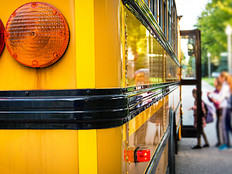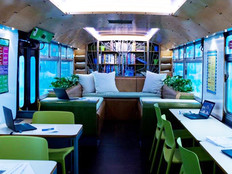Touch-Screen Tablets: The Perfect Tech for Kindergarteners
Think about one of the main activities most people associate with kindergarten: finger painting. It’s a simple, messy, fun way for kindergarteners to learn about color and expand the boundaries of their imagination.
But with tablets, and an app that simulates finger painting, teachers can unleash the artistic potential of their fresh-eyed students — without all of the usual mess and cleanup.
And the app is eco-friendly, because kids don’t have to use paper to create their art or water to wash their messy little hands. It’s a perfect example of technology creating new efficiencies in the classroom.
Similar scenarios are translating into real-world use in kindergarten classrooms across the nation.
In Pratt, Kan., at Southwest Elementary, kindergarteners are diving tablet-first into learning since the school purchased 75 tablets, according to a report from the Pratt Tribune.
Diane Ladenberger, a kindergarten teacher at the school, and Jessica Hanvey, a second-grade teacher, see nothing but positive results coming from the deployment of tablets in their classrooms:
Ladenburger's students can work out problems by drawing pictures. She illustrated by scribbling Johnny's three apples on the tablet's surface, then adding two apples belonging to someone else. The 3 + 2 math problem gets a visual component.
Of course, they could do the same problem on erasable whiteboards, but Hanvey said while she's handing out the boards, she will "lose" some of the students, and the lesson takes much more time.
Children can write their own stories and even use a photograph of themselves for the main character, then e-mail them to a publisher, or more often, to their parents.
"I haven't met a teacher who isn't excited about them," Ladenburger said of the iPads and their educational applications. "There is so much you can do with them."
Over in Utica, Mich., kindergarteners at Wiley Elementary also are entering the 2012 school year with a brand-new batch of tablets, according to a report from C & G News.
Thanks to a combination of tablets, interactive whiteboards, digital projectors and mobile apps, these kindergarteners are getting a head start in the 21st-century classroom.
Maureen Langenderfer, a kindergarten teacher at Wiley Elementary, said that the school district has really embraced the shift to a technology-infused kindergarten classroom.
“This is the first year of our blended learning model in Utica Community Schools, and we call it ‘kindergarten the Utica Way,’” Langenderfer said.
“Within our classrooms this year, we have six iPads and a station with six laptops; we’ve also got two interactive whiteboards and an Elmo (digital projector), which really assist teaching to the small groups in our classroom.
Lastly, in Martinsburg, W.V., at Rosemont Elementary School, kindergarteners were tapping away on their tablets as they played learning games and learned songs through the mobile device, according to a report from The Journal.
"There are learning games, as well as the music we learn in kindergarten, active songs to get up and do. I have some books they can find on the iPod. Kindergarten and first grade have them. We also have iPads accessible to our students," said kindergarten teacher Heather Whetsel.”
These three examples show the huge advantage that touch-based mobile devices have in becoming essential tools in the classroom for students at an early age. Since kids only need to touch, drag or point at objects on the screen, mastery of the device is easy. Compare that to a notebook, which requires young children to master the mouse, the cursor and the keyboard all at once.
The touch interface is one of the best examples of less being more in technology. Touch screens have made computing devices easier for adults and greatly improved usability for the youngest of our students.
So here’s to fewer finger-paint spills and magic-marker stains.








